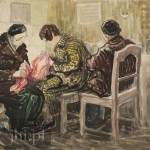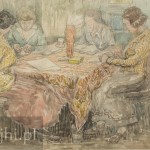Today I am sharing an excerpt from the memoir written by Moshe Rynecki’s son as well as three paintings. I share these two paragraphs because they give insight from the artist’s son about his father’s body of work.
In eight years, my parents’ home didn’t change much. More art. This one could notice immediately. And my father’s works were different. He matured and developed his unmistakable style. His colors became more alive than in his old paintings. His watercolors especially were brilliant, secure, positive, and somehow more courageous. The subject matter remained the same. Jews and poor people were painted. Begging in the streets, praying in synagogues, homes, and outdoors. He painted simple and holy days, men playing chess, or working. Women were sewing, knitting, or arranging flowers. If men were arguing, one could see and feel it was a Talmudic discussion. He did a few fairly large scenes of wedding details, such as under the canopy and with a jester explaining to the bride what life is all about. Gifts of bread—challah—were all meaningfully in place, and actually simple, although other details were excellent structurally. Typical faces and proper period clothes appeared. One could feel and sense that he was painting for the future generations. As he knew that this way of life was destined to disappear, he was almost prophetic. His work is educational and beautiful, full of feeling, full of energy, history, and customs of the days. He was blessed and he knew it.
He wanted to preserve and leave these works intact for the next generations, lest they won’t know, for lack of anyone else to do it. He had a sense of this responsibility and honesty. Yes, honesty to write in his own way what he considered important to preserve. He never sold any of his paintings or sculpture. Yes, he carved in wood, clay, and in the late thirties, in the first plastics. Serious, with a sense of forcefulness, his tremendous effort was saying: Don’t forget, this is your history. The examples left were miraculously saved.
Today I am showing three of the 17 paintings recently emailed to me by the Jewish Historical Institute (ZIH) in Warsaw. I like these three together because while all different, they represent a scene my great-grandfather frequently painted – group scenes of people working together. In the first two pieces the people are all sewing. In the first one it is women sewing together. In the second one it appears to be a man working at a sewing machine with someone doing handwork next to him. The painting on the far right appears to be women gathered around a table reading (studying?) together.
The piece at the far left, the women sitting in chairs, is undated. The tailor at the machine is dated 1935. The one at the far right of the women sitting at the table together is dated 1935.


